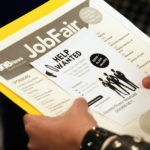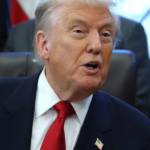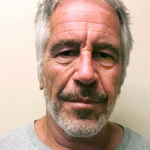If you ask Mark Zandi, chief economist for Moody’s Analytics, this old-time religion got a new lease on life in the Reaganomics of the 1980s. “You really start to see this in the Reagan era,” Zandi told Fortune. “That’s when you get a structural divergence between productivity growth and median wage growth.”
Zandi argued that many elements combined then to weaken labor in favor of capital income: globalization, the decline of unions and manufacturing and major tax reforms. “The share of national income going to labor has been trending down since the early 1980s,” he said, “and the share going to capital owners—those who already have wealth—has gone up.”
So what is it about 2025, five years after the pandemic severed something economically, that accelerated both sides of the “K” for the wealthy and the poor?
Shalett covered the K-shaped economy specifically in a November 3 research note, in the context of whether 2026 marks an early or late stage of the economic cycle for investors. “Decoding this conundrum may hinge on the so-called K-shaped economy,” she wrote, “a concept that captures the widening chasm between the ‘haves’ and ‘have-nots.’”
Then Shalett said the situation is actually even worse than what Zandi produced: “For the U.S. consumer, wealth concentration has produced a situation where the top 40% of households by income account for approximately 60% of all spending; those households, in turn, control nearly 85% of America’s wealth, two-thirds of which is directly tied to the stock market, which has climbed more than 90% in three years.” She calculated that spending by the wealthiest households was growing 6x-7x faster than for the lowest cohort.
The concept of a bifurcated economy has been baked into American society longer than even the days of Reagan, according to Tyler Schipper, associate professor of economics at the University of St. Thomas.
“There’s this underlying thing that has been true for decades and decades and decades,” Schipper told Fortune. “Number one, lower income households always struggle more in the economy. They tend to be more impacted by price changes because they’re spending a higher percentage of their income.
“And second, that it tends to be that after each recession, lower income workers fall further behind in the income distribution,” he added.
But another part of the resurgence of discussions about a bifurcated economy comes from the relative nature of a K-shaped economy, according to Schipper. While the economy has historically been two-tiered, diverging consumer sentiment has also contributed to a narrative that two income groups are moving away from each other.
Cheap money in the 2010s and early pandemic years boosted stocks and home values, but the 2022-and-on tightening squeezed borrowers and renters without necessarily reversing those gains. That means even as inflation has cooled, the damage lingered as asset holders retained their windfall but wage earners bore the brunt of disinflation.
“Folks in the top third of the income and wealth distribution are doing well, but the remaining two-thirds of Americans are struggling… they borrowed during the pandemic when rates were low, and now they’re having to pay on that debt at a higher rate,” Zandi said.
Though Fed chair Powell has acknowledged today’s K-shaped economy, a restrictive monetary policy is helping keep it in place, Sahm argued, making it unlikely for the two diverging K lines to come any closer together.
“We have a Fed that’s still trying to fight inflation that’s been elevated, and part of the tool that they have for fighting inflation is interest rates are elevated, and they’ve been elevated for some time,” Sahm said. “This is the way restrictive monetary policy works: It’s going to hit households hardest who are more financially constrained.”
Zandi had a different perspective. He argued that the gap will require policy changes far beyond the Fed’s remit.
“The Fed can’t fix the K-shaped economy,” he said. “It can only stabilize prices and employment. The distributional effects are up to fiscal policy.” Instead, Zandi argued for a reversal of some choices made on the fiscal side that would “do no harm” to lower-and-middle-income Americans.
“Don’t impose tariffs—that exacerbates inequality,” he said. “Lower- and middle-income households spend a much higher share of their budget on imported products like food, clothing, and cars.”
He also criticized President Donald Trump’s “highly restrictive” immigration policy, which he said hurts jobs for industries that rely on immigrants, such as construction, agriculture and manufacturing broadly.
Clear evidence of a two-tiered economy doesn’t mean a recession is imminent, economists said. It does, however, mean that if economic indicators were to take a nosedive, the risk of a recession would increase.
“The K-shaped economy, the bifurcated economy, is potentially a more vulnerable economy,” Sahm said.
“Anytime you have that, you’re more vulnerable if something bad happens,” Sahm said.









